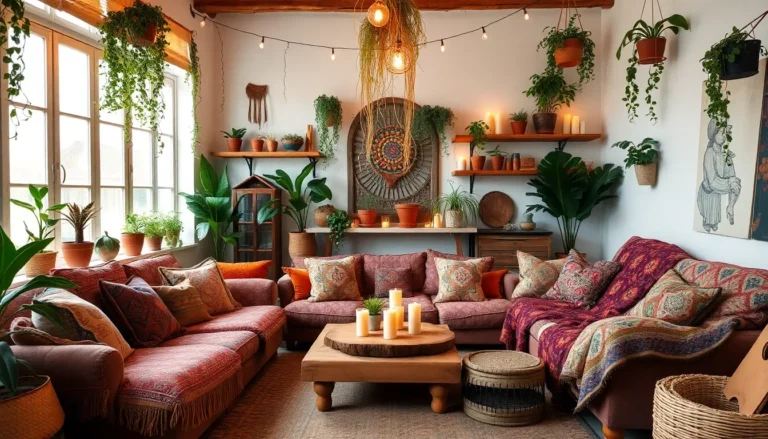Table of Contents
ToggleIn a world that often feels chaotic and overwhelming, the concept of “cozy by design” is like a warm hug on a chilly day. It’s not just about fluffy blankets and steaming mugs of cocoa—it’s a lifestyle choice that transforms spaces into havens of comfort. Imagine curling up in a room that wraps you in serenity, where every corner whispers relaxation.
Overview of Cozy by Design
Cozy by design represents a holistic approach to creating inviting spaces. This concept emphasizes the combination of aesthetics and functionality. Elements like soft textures and warm colors play a crucial role in enhancing comfort. Furniture arrangements focus on promoting relaxation and conversation.
Lighting significantly impacts the atmosphere. Natural light creates a warm environment while adjustable fixtures allow for customization based on the time of day. It’s important to choose materials that contribute to warmth, such as wood, textiles, and metals.
Plants add life and freshness to a cozy design. Including greenery not only improves air quality but also creates a serene ambiance. Accessories like candles and art pieces enhance the overall aesthetic, making spaces more personalized and inviting.
Furniture selection aligns with comfort and style. Comfortable seating encourages people to unwind while maintaining design integrity. Versatile layouts adapt to different settings, ensuring functionality without sacrificing coziness.
Textiles play a vital role in achieving a cozy environment. Soft blankets, plush rugs, and inviting cushions invite people to relax and feel at ease. Color palettes often lean toward earthy tones that promote tranquility, creating a balanced visual experience.
Overall, cozy by design is about creating spaces that embrace comfort and well-being. This approach transforms living areas into true havens, fostering relaxation and rejuvenation. By carefully considering elements of design, one can cultivate an inviting atmosphere that reflects personal style while prioritizing comfort.
Key Elements of Cozy Design
Creating a cozy space involves thoughtful choices that enhance comfort and tranquility. Essential elements include color palettes and textures that foster an inviting atmosphere.
Color Palettes
Color selection plays a crucial role in setting a cozy tone. Warm colors, such as earthy tones like terracotta, soft browns, and muted greens, evoke a sense of warmth and relaxation. Shades like soft beige or creamy whites can act as a perfect backdrop, allowing other colors to stand out. Complementary accents in deeper hues or pastel shades add depth without overwhelming the senses. Natural, soft colors promote tranquility and can be easily adapted to fit various design styles. Rooms that incorporate balanced color schemes feel harmonious and inviting, reflecting personal style while nurturing a calming environment.
Textures and Materials
Textures significantly enhance the sensory experience of a space. Soft fabrics, such as cotton, linen, and wool, create a welcoming touch when used for throws, cushions, and curtains. Incorporating varied materials, like reclaimed wood or natural stone, enriches the overall ambiance. Plush rugs underfoot add warmth and comfort, making spaces feel cozier. Layers of textile, from woven baskets to knitted elements, also contribute to a relaxed vibe. Selecting natural materials fosters a connection to the outdoors, reinforcing the calming essence of cozy design. Such elements invite tactile engagement, inviting relaxation and social interaction throughout the home.
Creating Cozy Spaces
Cozy spaces create warmth and invite relaxation. A well-designed environment promotes comfort and well-being.
Living Room Essentials
Soft seating options, such as overstuffed sofas and armchairs, enhance comfort in the living room. Layered textiles, including throw pillows and blankets, add visual interest. Warm lighting, like floor lamps and table lamps with adjustable shades, sets the mood. Natural elements, such as wooden coffee tables or plants, bring life into the space. Incorporating personal touches, like family photos and art, fosters connection and sentiment. Arrangement of furniture encourages conversation, providing an inviting atmosphere for guests. These essentials collectively create a warm, comfortable environment.
Bedroom Comforts
Bedding plays a crucial role in promoting restful sleep. High-quality mattresses and soft sheets create a nurturing sleep space. Plush comforters and a variety of pillows enhance relaxation, making the room inviting. Dim lighting, like fairy lights or bedside lamps, establishes a calming ambiance. Adorning walls with soothing art or peaceful imagery contributes to a tranquil environment. Using earthy color palettes infuses warmth, fostering a sense of serenity. Curtains that block light allow for better sleep quality. These comforts transform bedrooms into serene retreats.
The Impact of Cozy Design on Well-being
Cozy design significantly influences overall well-being. Environments fostering comfort promote mental relaxation. Warm colors evoke feelings of safety and contentment. Spaces filled with soft textures support a sense of physical ease. Cozy areas encourage social interaction, enhancing community and connection.
Natural lighting plays a crucial role in creating a warm atmosphere. It uplifts moods and energizes spaces. Control over light intensity contributes to personalized comfort levels. Living areas showcasing natural elements, such as plants, boost air quality and promote tranquility. They also create a connection to nature, further enhancing relaxation.
Quality furniture enhances comfort without compromising aesthetics. Thoughtful arrangements allow for easy conversation and socializing. High-quality textiles, such as soft blankets and plush rugs, invite relaxation and warmth. Bedroom spaces benefit greatly from cozy design, as restful materials support restorative sleep. Soothing decor elements create a calming environment that promotes well-being.
Accessories, like candles and art pieces, can personalize spaces and evoke positive emotions. An inviting ambiance often leads to reduced stress levels and increased happiness. The prioritization of comfort in a cozy design leads to enhanced health benefits, both mental and physical. Spaces reflecting personal style contribute to a greater sense of identity and belonging.
Trends in Cozy Design
Soft textures dominate cozy design trends, creating inviting and tactile spaces. Warm colors, including earthy tones and soft neutrals, play a vital role in establishing comforting atmospheres. Layered textiles enrich the environment, allowing for various comfort levels and visual interest. Plush rugs often serve as a foundation for cozy areas, inviting guests to relax and gather.
Natural lighting captures attention, enhancing both mood and ambiance. Adjustable fixtures enable customization, catering to personal preferences throughout the day. The integration of greenery is notable, as plants not only purify air but also add vibrancy to interiors. Furniture placement emphasizes conversation areas, making social interaction effortless and enjoyable.
Quality materials elevate the overall experience, with wood, textiles, and metals all contributing to a sense of warmth. Accessories like candles create warmth and enhance the cozy aesthetic. Art pieces provide personal touches, reflecting individual style while making spaces feel more lived in.
Fostering well-being continues to be a priority, with cozy design increasingly recognized for its positive effects on mental health. Choosing comfort-focused furniture promotes relaxation, encouraging restful environments in bedrooms and living spaces alike. Overall, trends in cozy design underscore the balance between aesthetic appeal and functional comfort, turning homes into sanctuaries of relaxation.
Conclusion
Embracing the “cozy by design” philosophy transforms living spaces into serene retreats. By thoughtfully combining textures colors and furniture arrangements individuals can create environments that foster relaxation and connection. The careful selection of materials and the inclusion of natural elements enhance both comfort and aesthetic appeal.
As trends continue to evolve the core principles of cozy design remain relevant. Prioritizing well-being through inviting atmospheres not only elevates personal style but also nurtures mental health. Ultimately creating a cozy sanctuary is about making intentional choices that reflect one’s personality while inviting warmth and tranquility into everyday life.







